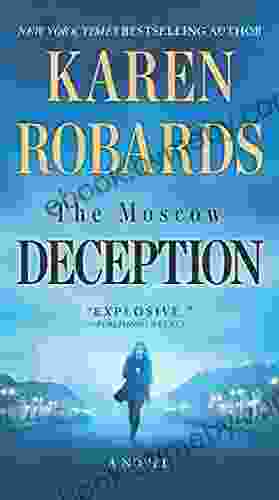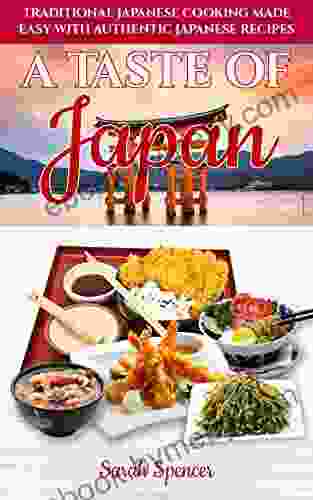Taste of Japan: An Exploration of Japanese Cuisine and Culture

Japan is a country with a rich and diverse culinary tradition. Japanese cuisine is known for its delicate flavors, fresh ingredients, and beautiful presentation. In recent years, Japanese food has become increasingly popular around the world. This is due in part to the popularity of sushi and other Japanese dishes, but also to the growing interest in Japanese culture and lifestyle.
The history of Japanese cuisine can be traced back to the縄文 period (14,000-300 BCE). During this time, the Japanese people lived a hunter-gatherer lifestyle and ate a diet that consisted primarily of fish, shellfish, and wild vegetables.
During the Yayoi period (300 BCE-300 CE),the Japanese people began to cultivate rice. Rice quickly became a staple of the Japanese diet, and it remains so today.
4.5 out of 5
| Language | : | English |
| File size | : | 55982 KB |
| Text-to-Speech | : | Enabled |
| Screen Reader | : | Supported |
| Enhanced typesetting | : | Enabled |
| Word Wise | : | Enabled |
| Print length | : | 266 pages |
| Lending | : | Enabled |
The Nara period (710-794 CE) saw the of Buddhism to Japan. Buddhism had a significant impact on Japanese cuisine, as it led to the adoption of vegetarianism by many Japanese people.
The Heian period (794-1185 CE) was a time of great cultural refinement in Japan. This period saw the development of many of the traditional Japanese dishes that are still enjoyed today, such as sushi, sashimi, and tempura.
The Edo period (1603-1868 CE) was a time of great economic growth and prosperity in Japan. This period also saw the development of many new Japanese dishes, such as ramen, udon, and soba.
The Meiji period (1868-1912 CE) saw the opening of Japan to the West. This led to the of new ingredients and cooking techniques to Japan.
The Showa period (1926-1989 CE) was a time of great economic growth and prosperity in Japan. This period also saw the development of many new Japanese dishes, such as karaage, tonkatsu, and yakitori.
The Heisei period (1989-present) has seen the continued globalization of Japanese cuisine. Japanese dishes are now enjoyed all over the world.
There are many different types of Japanese cuisine. Some of the most popular include:
- Sushi: Sushi is a type of Japanese dish that consists of vinegared rice combined with other ingredients, such as seafood, vegetables, or eggs.
- Sashimi: Sashimi is a type of Japanese dish that consists of thinly sliced raw fish or seafood.
- Tempura: Tempura is a type of Japanese dish that consists of seafood or vegetables that are coated in a batter and then deep-fried.
- Ramen: Ramen is a type of Japanese noodle soup that is made with wheat noodles, broth, and various toppings, such asチャーシュー (chāshū),メンマ (menma),andネギ (negi).
- Udon: Udon is a type of Japanese noodle soup that is made with thick wheat noodles, broth, and various toppings.
- Soba: Soba is a type of Japanese noodle soup that is made with thin buckwheat noodles, broth, and various toppings.
The ingredients used in Japanese cuisine are typically fresh and seasonal. Some of the most common ingredients include:
- Rice: Rice is a staple of the Japanese diet. It is used to make sushi, sashimi, tempura, ramen, udon, and soba.
- Seafood: Seafood is another important ingredient in Japanese cuisine. It is used to make sushi, sashimi, tempura, and ramen.
- Vegetables: Vegetables are also widely used in Japanese cuisine. Some of the most common vegetables used include cabbage, carrots, onions, and mushrooms.
- Soy sauce: Soy sauce is a fermented sauce that is made from soybeans. It is used to flavor many Japanese dishes, such as sushi, sashimi, and ramen.
- Mirin: Mirin is a sweet rice wine that is used to flavor many Japanese dishes, such as sushi, sashimi, and tempura.
- Sake: Sake is a Japanese rice wine that is used to drink or cook with.
There are many different techniques used in Japanese cuisine. Some of the most common include:
- Cutting: Cutting is an important technique in Japanese cuisine. Japanese chefs use a variety of knives to cut ingredients into precise shapes and sizes.
- Cooking: Japanese chefs use a variety of cooking techniques, such as grilling, steaming, and boiling.
- Presentation: Presentation is also important in Japanese cuisine. Japanese chefs take great care to arrange their dishes in a beautiful and appetizing way.
Japanese cuisine is more than just food. It is also a reflection of Japanese culture. Japanese food is often served in a communal setting, and it is considered to be a way to bring people together.
Japanese cuisine also plays an important role in Japanese festivals and holidays. For example, mochi is a type of Japanese rice cake that is traditionally eaten at the New Year.
Japanese cuisine is a rich and diverse culinary tradition. It is known for its delicate flavors, fresh ingredients, and beautiful presentation. Japanese food is also a reflection of Japanese culture, and it plays an important role in Japanese festivals and holidays.
4.5 out of 5
| Language | : | English |
| File size | : | 55982 KB |
| Text-to-Speech | : | Enabled |
| Screen Reader | : | Supported |
| Enhanced typesetting | : | Enabled |
| Word Wise | : | Enabled |
| Print length | : | 266 pages |
| Lending | : | Enabled |
Do you want to contribute by writing guest posts on this blog?
Please contact us and send us a resume of previous articles that you have written.
 Book
Book Novel
Novel Page
Page Chapter
Chapter Text
Text Story
Story Genre
Genre Reader
Reader Library
Library Paperback
Paperback E-book
E-book Magazine
Magazine Newspaper
Newspaper Paragraph
Paragraph Sentence
Sentence Bookmark
Bookmark Shelf
Shelf Glossary
Glossary Bibliography
Bibliography Foreword
Foreword Preface
Preface Synopsis
Synopsis Annotation
Annotation Footnote
Footnote Manuscript
Manuscript Scroll
Scroll Codex
Codex Tome
Tome Bestseller
Bestseller Classics
Classics Library card
Library card Narrative
Narrative Biography
Biography Autobiography
Autobiography Memoir
Memoir Reference
Reference Encyclopedia
Encyclopedia Neil Oliver
Neil Oliver Kaitlyn Duling
Kaitlyn Duling Karl Marlantes
Karl Marlantes William L Andrews
William L Andrews Juliet Miller
Juliet Miller Katie Young Gerald
Katie Young Gerald Kate Mosse
Kate Mosse Keisha Quallo
Keisha Quallo H G Wells
H G Wells Karen Stocker
Karen Stocker Karen A Moon
Karen A Moon Justin Coulson
Justin Coulson Richard Marcinko
Richard Marcinko Olaf Baker
Olaf Baker Kellie Stafford
Kellie Stafford Patrick Schulte
Patrick Schulte R Scott Thornton
R Scott Thornton Keelin Shanley
Keelin Shanley Kathy Cano Murillo
Kathy Cano Murillo Kelle James
Kelle James
Light bulbAdvertise smarter! Our strategic ad space ensures maximum exposure. Reserve your spot today!

 Owen SimmonsThe Guardian: An International Spy Thriller That Will Keep You on the Edge of...
Owen SimmonsThe Guardian: An International Spy Thriller That Will Keep You on the Edge of...
 E.E. CummingsUnlock the Secrets of Pain-Free Paddling and Surfing with Optimized Movement
E.E. CummingsUnlock the Secrets of Pain-Free Paddling and Surfing with Optimized Movement Ryūnosuke AkutagawaFollow ·19.1k
Ryūnosuke AkutagawaFollow ·19.1k Chase SimmonsFollow ·2.3k
Chase SimmonsFollow ·2.3k Billy PetersonFollow ·19.9k
Billy PetersonFollow ·19.9k Cristian CoxFollow ·18.5k
Cristian CoxFollow ·18.5k J.R.R. TolkienFollow ·8.5k
J.R.R. TolkienFollow ·8.5k Clark BellFollow ·13.2k
Clark BellFollow ·13.2k W. Somerset MaughamFollow ·5.2k
W. Somerset MaughamFollow ·5.2k Darnell MitchellFollow ·14.2k
Darnell MitchellFollow ·14.2k

 George Orwell
George OrwellPandemic with Dogs: Two Essays
By Susannah Charleson In the midst of...

 Leo Mitchell
Leo MitchellAdam Smith's The Wealth of Nations: A Classic Treatise on...
Adam Smith's The...

 Cade Simmons
Cade SimmonsUnlock Your Communication Potential: Effective Techniques...
Communication is a fundamental...

 Floyd Richardson
Floyd RichardsonFire and Ashes: Success and Failure in Politics
Fire and Ashes: Success and...

 Oliver Foster
Oliver FosterUnlock the Enchanting Mystery of Ken Follett's "The Key...
Embark on a captivating literary journey into...
4.5 out of 5
| Language | : | English |
| File size | : | 55982 KB |
| Text-to-Speech | : | Enabled |
| Screen Reader | : | Supported |
| Enhanced typesetting | : | Enabled |
| Word Wise | : | Enabled |
| Print length | : | 266 pages |
| Lending | : | Enabled |










